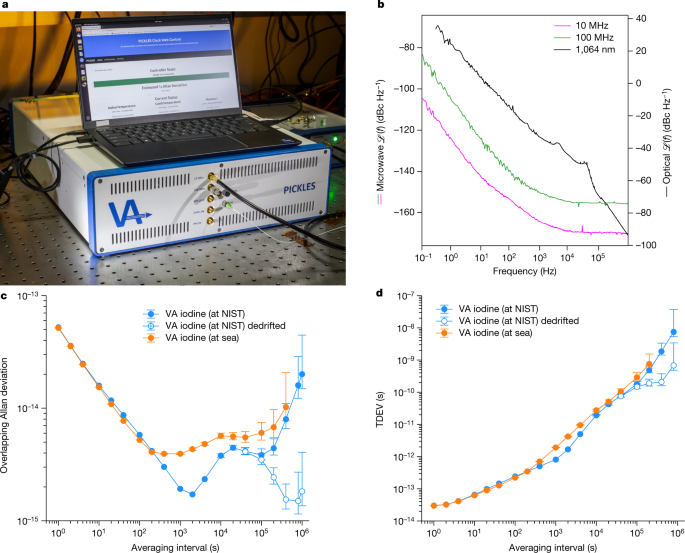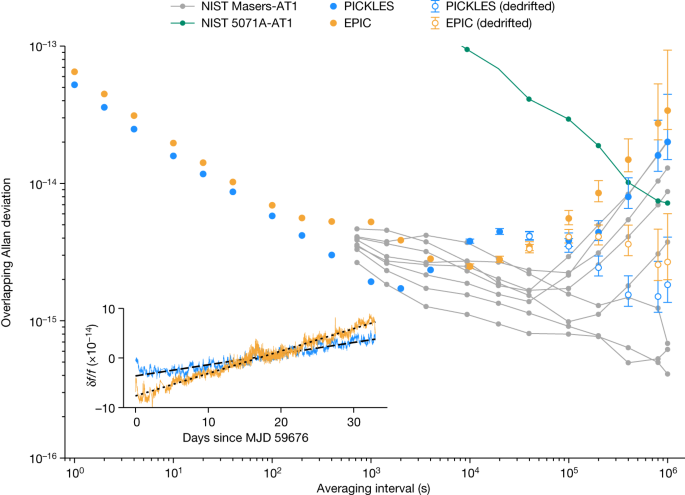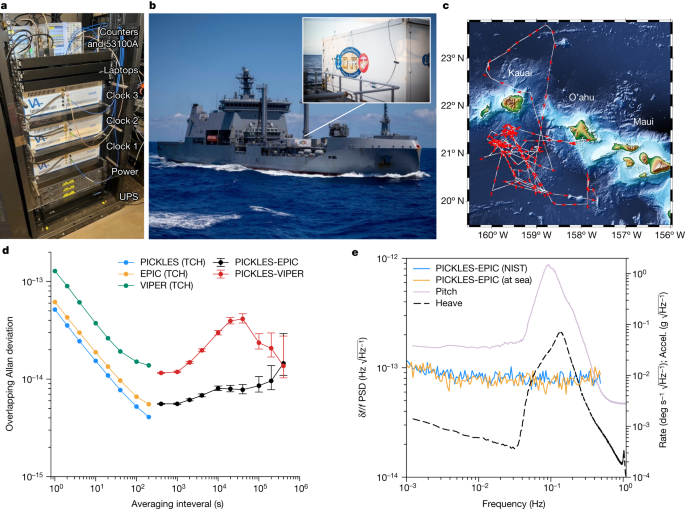[ad_1]
Atomic timekeeping plays an essential role in modern infrastructure, from transportation to telecommunications to cloud computing. Billions of devices rely on the Global Navigation Satellite System for accurate positioning and synchronization11. The Global Navigation Satellite System is a network of distributed, high-performance microwave-based atomic clocks that provide nanosecond-level synchronization globally. The emergence of fieldable optical timekeeping, which offers femtosecond timing jitter at short timescales and multiday, subnanosecond holdover, along with long-distance femtosecond-level optical time transfer12, paves the way for global synchronization at picosecond levels.
Molecular iodine (I2) has a legacy as an optical frequency standard13,14,15,16,17. Several iodine transitions are officially recognized as length standards18, and the species underpinned one of the first demonstrations of optical clocks19,20. More recently, iodine frequency standards have been investigated for space missions21,22,23,24. Here we report the deployment of several high-performance, fully integrated iodine optical clocks and highlight their ability to maintain nanosecond (ns)-level timing for several days while continuously operating at sea.
These clocks use a robust vapour cell architecture that uses no consumables, does not require laser cooling or a prestabilization cavity and is first-order insensitive to platform motion. Similar approaches with rubidium vapour cells are under development25,26,27. Importantly, iodine clocks use mature laser components at 1,064 nm and 1,550 nm. The focus on a robust laser system rather than a high-performance atomic species resolves system-level issues with dynamics, lifetime, autonomy and cost. Although not as accurate as laboratory optical clocks using trapped atoms or ions, iodine clocks can provide maser-level performance in a compact, robust and mobile package.
Initial clock prototypes were integrated into 35 l, 3 U 19-inch rackmount chassis, shown in Fig. 1a. Clock outputs are at 100 MHz, 10 MHz and 1 pulse per second. Auxiliary optical outputs are provided for the frequency comb and clock laser (1,550 nm and 1,064 nm, respectively). The physics packages, which include the spectrometer, laser system and frequency comb, were designed and built in-house to reduce system-level size, weight and power (SWaP). Field-programmable gate array-based controllers perform digital locks for the laser and frequency comb, servo residual amplitude modulation (RAM) and stabilize the pump and probe powers. The clock operates using a commercial 1 U rackmount power supply and control laptop. Each system consumes about 85 W (excluding the external power supply) and weighs 26 kg.
a, The 3 U, 19-inch rackmount iodine optical clock occupies a volume of 35 l and consumes less than 100 W. b, Measured phase noise for the iodine clock at 10 MHz, 100 MHz and 1,064 nm. c, Overlapping Allan deviation for the iodine clock operating at NIST and at sea. At short timescales, the instability in a dynamic environment is identical to the laboratory. The iodine clock can maintain less than 10−14 frequency instability for several days despite several-degree temperature swings, significant changes in relative humidity and changing magnetic fields. d, The clocks can maintain holdovers of 10 ps for several hours and 1 ns for several days, showing their potential as the basis for a picosecond-level timing network.
Two clocks with identical hardware (PICKLES and EPIC) were developed with physics packages targeting short-term instability below 10−13/√τ, comparable to commercial masers. A third clock (VIPER) with a relaxed performance goal of less than 5 × 10−13/√τ was built using a smaller iodine spectrometer and simplified laser system to reduce the physics package volume by 50% and power consumption by 5 W; the chassis volume was unchanged. The frequency comb design and control electronics for PICKLES, EPIC and VIPER are largely identical.
In April 2022, PICKLES and EPIC were shipped to the National Institute of Standards and Technology (NIST) in Boulder, Colorado for assessment against the Coordinated Universal Timescale maintained at NIST, that is, UTC(NIST)28. The clocks operated on an optical table without any further measures to insulate them from the NIST laboratory environment, which is temperature stabilized. The laboratory was also in active use throughout the measurement campaign. The 10 MHz tone from each clock was compared against a 5 MHz maser signal with a Microchip 53100A phase noise analyser in a three-cornered hat (TCH) configuration. NIST maser ST05 (Symmetricom MHM-2010) was selected as the lowest drift maser in the ensemble (3 × 10−17 per day). The measurement scheme allows for decorrelating the three clocks at short timescales and measuring against the NIST composite timescale AT1, derived from the maser ensemble, at longer timescales. Importantly, ST05 was operated in an environmental chamber in a separate laboratory, providing an environmentally uncorrelated reference. The 1,064 nm optical beatnote between PICKLES and EPIC was simultaneously monitored for cross-validation. After installation, the clocks were left to operate autonomously. The measurement setup was remotely monitored without intervention from our California headquarters, and the comparison was intentionally terminated after 34 days on return to NIST.
The overlapping Allan deviation for the entire 34-day dataset without any windowing, dedrifting or filtering is shown in Fig. 2. To present the individual clock performance, the Allan deviation plot uses the 1–1,000 s instability extracted from TCH analysis and the direct instability against ST05 for time periods longer than 1,000 s (Extended Data Fig. 3). The PICKLES and EPIC short-term instabilities of 5 × 10−14/\(\sqrt{\tau }\) and 6 × 10−14/\(\sqrt{\tau }\), respectively, outperform the short-term performance of the ST05 maser. Both iodine clocks exhibit fractional frequency instabilities less than 5 × 10−15 after 100,000 s of averaging, equivalent to a temporal holdover below 300 ps after 1 day.
Overlapping Allan deviation for the 10 MHz outputs of the two iodine clocks measured against the UTC(NIST) timebase for 34 days (blue and orange traces). The clocks exhibit a raw frequency instability of 4 × 10−15 (PICKLES) and 6 × 10−15 (EPIC) after 105 s of averaging and maintain instability less than 10−14 for nearly 6 days (PICKLES). With linear drift removal, the frequency instability improves to less than 2 × 10−15 (PICKLES) and less than 3 × 10−15 (EPIC) for 106 s (open circles). The performance of a variety of NIST masers against the composite AT1 timescale is shown for comparison (grey traces) as well as a commercial caesium clock (green trace). The long-term frequency record for the two iodine clocks against ST05 is shown as an inset. Each trace is shown as a 1,000 s moving average. The linear drift for each clock is observed to be several 10−15 per day. MJD is the modified Julian day.
The data also provided an initial measure of the long-term stability of the iodine clocks (Fig. 2, inset). Measured against UTC(NIST), the drift rates for PICKLES and EPIC are 2 × 10−15 and 4 × 10−15 per day, respectively, consistent with the long-term accuracy of an iodine vapour cell measured over the course of a year19. This drift rate is about ten times lower than a typical space-qualified rubidium atomic frequency standard after more than a year of continuous operation29,30. Moreover, the iodine-stabilized laser provides a drift rate roughly 10,000–100,000× lower as compared to typical ultralow expansion (ULE) optical cavities31,32. This drift rate has been consistent for multiple measurement campaigns over several months (Extended Data Fig. 5). Removal of linear drift from the frequency data indicates that the two clocks continue to hold less than 3 × 10−15 instability after more than 106 s (approximately 12 days) of averaging, equivalent to 1 ns timing error over this period. Without drift removal, the long-term clock performance is competitive with the NIST active hydrogen masers; drift removal puts the clock instability on par with the highest-performing masers in the NIST bank. Notably, to achieve the drift rates observed in Fig. 2, the NIST masers are operated continuously for years and housed in environmental chambers with a volume of nearly 1,000 l to stabilize temperature and humidity to better than 100 mK and 1%, respectively (ref. 33 and J. Sherman, private communication). The laboratory housing PICKLES and EPIC was stable to hundreds of millikelvins throughout the measurement campaign, which started a few days after a cross-country shipment. Finally, the raw iodine clock performance is below NIST’s commercial caesium beam clock (Microchip 5071A) for 5.5 days; the dedrifted iodine performance is below caesium for all observed timescales.
A broad feature with a peak deviation of 4 × 10−15 is evident in the PICKLES Allan deviation at roughly 20,000 s (about 7 h) timescales. The equivalent optical frequency deviation of 2 Hz corresponds to a shift of about 2 ppm of the hyperfine transition line centre. We suspect that the origin of this plateau in PICKLES is RAM coupling through a spurious etalon in the spectrometer. By modifying the build procedure, this etalon was mitigated during the build of the EPIC spectrometer.
The iodine clock exhibits excellent phase noise for the 10 and 100 MHz tones derived by optical frequency division as well as the 1,064 nm optical output (Fig. 1b). The phase noise at microwave frequencies is lower than commercial atomic-disciplined oscillators, highlighting the benefits of optical frequency division where the fractional noise of the iodine-stabilized laser is transferred to the frequency comb repetition rate.
Following the measurement against an absolute reference at NIST-Boulder, three optical clocks were brought to Pearl Harbor, HI in July 2022 to participate in the Alternative Position, Navigation and Time (A-PNT) Challenge at Rim of the Pacific (RIMPAC) 2022, the world’s largest international maritime exercise. A-PNT was an international demonstration of quantum technologies with academic, government and industry participants. Several prototype quantum technologies including optical clocks34,35 and atomic inertial sensors were fielded36. The iodine clocks were installed in an open server rack along with a commercial 1 U power supply for each clock, three control laptops and an uninterruptable power supply backup for the system (Fig. 3a). The rack also contained three frequency counters to collect the three pairwise beatnotes and a 53100A phase noise analyser to compare the 100 MHz tone derived from each clock’s frequency comb against the other two in a TCH configuration. The total stackup, including three independent clocks, power supplies, computer controls and metrology systems, occupied a rack height of 23 U. The server rack was hard-mounted to the floor of a Conex cargo container, which was craned onto the deck of the New Zealand naval ship HMNZS Aotearoa (Fig. 3b), where it remained during the three weeks the vessel was at sea. Once the ship left port, the three clocks operated without user intervention for the duration of the exercise, apart from one restart of VIPER due to a software fault in the external power supply.
a, Clock stackup for RIMPAC 2022. The server rack contained three independent optical clocks, a 1 U power supply and control laptop for each clock, an uninterruptable power supply and the measurement system in a total rack volume of 23 U. b, The cargo container housing the clocks was craned onto the deck of the HMNZS Aotearoa, where it remained for the three-week naval exercise. c, A GPS track of the Aotearoa’s voyage around the Hawaiian Islands. The ship started and ended its voyage at Pearl Harbor, O’ahu. d, Overlapping Allan deviation during the underway. For time periods less than 100 s, individual clock contributions are extracted with a TCH analysis; directly measured pairwise instabilities are shown for periods longer than 100 s. The EPIC–PICKLES pair maintains a fractional frequency instability of 8 × 10−15 after 105 s of averaging, corresponding to a temporal holdover of 400 ps. e, PSD for the PICKLES–EPIC frequency fluctuations at NIST and at sea with the recorded ship pitch and heave (rotation and acceleration on the other ship axes showed similar behaviour). The PICKLES–VIPER PSD (not shown) showed a similar immunity to the ship motion. Photograph of the ship by T. Bacon, DVIDS.
The operating environment during the ship’s underway differed significantly from NIST, but the clocks still operated continuously with high performance (Fig. 1c,d). Although the Conex was air-conditioned, the internal environment underwent swings of roughly 2–3 °C peak-to-peak temperature and 4%–5% relative humidity over a day–night cycle. The clock rack was located directly in front of the air conditioning unit, which cycled on and off throughout the day. The clocks also operated continuously through ship motion. The rotational dynamics of the ship included a peak pitch of ±1.5° at a rate of ±1.2° s−1 and a peak roll of ±6° at a rate of ±3° s−1. Similarly, the maximum surge, sway and heave accelerations were ±0.4, ±1.5 and ±1.2 m s−2, respectively. A vertical root mean square vibration of 0.03 m s−2 (integrated from 1 to 100 Hz) was also experienced. Operation in dynamic environments highlights the robust, high-bandwidth clock readout (greater than 10 kHz control bandwidth) enabled by a vapour cell.
The vessel travelled in all four cardinal directions during the exercise, illustrated by the GPS-tracked trajectory in Fig. 3c. The National Oceanic and Atmospheric Administration geomagnetic model for Earth’s magnetic field at this latitude and longitude shows that the projection of the Earth’s field on the clocks varied by ±270 mG throughout the underway (https://www.ngdc.noaa.gov/geomag/geomag.shtml).
The overlapping Allan deviations measured during the voyage are shown in Fig. 3d. For time periods less than 100 s, the individual clock contributions are extracted with a TCH analysis. Directly measured pairwise instabilities are shown for longer time periods. There was no degradation in the clock signal-to-noise ratio (SNR) despite ship vibration and motion; the short-term performance for the three clocks was identical to that observed at NIST for up to 1,000 s (Fig. 1c,d). All three clocks showed immunity to dominant ship motion in the band at about 0.1 Hz (Fig. 3e). A medium timescale instability was driven by the day–night temperature swing in the Conex. Nonetheless, the PICKLES–EPIC clock pair maintains 8 × 10−15 combined instability at 100,000 s without drift correction, equivalent to temporal holdover of roughly 400 ps over 24 h. The PICKLES–EPIC data exhibit a temperature-driven instability in the 103–105 s range due to insufficient air conditioner capacity during the day. This plateau at 104 s originates from EPIC on the basis of environmental chamber testing following RIMPAC, but its performance is still within two times that seen at NIST. Finally, the drift rate for PICKLES–EPIC over this period was similar to that observed at NIST (Extended Data Fig. 5). This long-term performance illustrates the robustness of iodine-based timekeeping as the clocks experienced diurnal temperature swings of several degrees, platform motion arising from ship dynamics and constant movement through Earth’s magnetic field.
VIPER exhibits a short-term instability of 1.3 × 10−13/\(\sqrt{\tau }\) as well as a more prominent diurnal temperature instability that peaks at 4 × 10−14 near 40,000 s (corresponding to roughly 1 day periodic instability). The VIPER physics package is an earlier design with relaxed performance goals that results in a larger temperature coefficient than the other two clocks. Nonetheless, this system can average over the diurnal temperature fluctuation and maintain an instability of 2.5 × 10−14 after 1 day of averaging. VIPER showed a drift rate similar to PICKLES and EPIC during the underway. Importantly, the VIPER physics package does not include magnetic shields yet still provides excellent frequency stability despite motion through Earth’s magnetic field.
Summary data for PICKLES, the highest-performing clock at NIST and at sea, are shown in Fig. 1c,d. Single-clock performance at sea comprises the decorrelated instability for τ less than 200 s (Fig. 3d: blue trace) and the PICKLES–EPIC data for longer periods (Fig. 3d: black trace). The PICKLES–EPIC data are normalized by 1/\(\surd 2\) as an upper bound for PICKLES, assuming equal contributions. Notably, the performance of PICKLES is largely unchanged at sea.
All three clocks were colocated for the at-sea testing; therefore, there is potential for correlated environmental sensitivities due to ship dynamics, motion in Earth’s magnetic field and temperature and humidity variations inside the Conex. Standard reference clocks (such as a caesium beam clock or GPS-disciplined rubidium) were not available for comparison. However, simultaneous evaluation of three clocks raises the level of common mode rejection required to mask fluctuations common to the three systems, particularly given VIPER’s differing spectrometer and laser system designs. Pairing the at-sea test data of three clocks with environmental testing on land provides confidence that potential correlations are below the measured instability (Supplementary Information).
Iodine has proven to be a capable platform for the development of practical optical timekeeping systems. The unique combination of SWaP, phase noise, frequency instability, low environmental sensitivity and operability on moving platforms distinguishes the approach from both commercial microwave clocks and higher-performing laboratory optical clocks. It compares favourably to active hydrogen masers in terms of long-term holdover while outperforming maser phase noise and instability at short timescales. To deliver peak performance, masers typically operate in large (approximately 1,000 l) environmental chambers that carefully regulate the temperature and humidity, limiting their use to the laboratory. Conversely, no special measures were taken to control the operating environment of the iodine clock at both NIST and throughout the RIMPAC underway. Similar to caesium beam clocks, the 3 U rackmount form factor lends itself to use outside the laboratory.
To our knowledge, these clocks are the highest-performing sea-based clocks until now. The integration, packaging and environmental robustness required to achieve such operation is a significant technological step towards widespread adoption of optical timekeeping. Since these field demonstrations, further advancement in the performance and SWaP of the rackmount clocks has been accomplished in our next-generation system, including decreasing short-term instability to 2 × 10−14/√τ, lowering the overall system SWaP to 30 l, 20 kg and 70 W and eliminating the external power supply.
[ad_2]
Source Article Link




